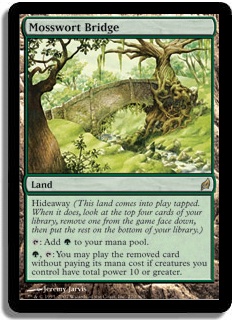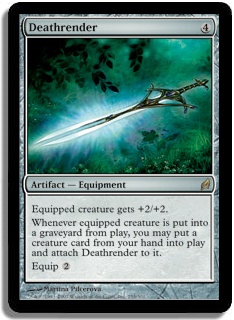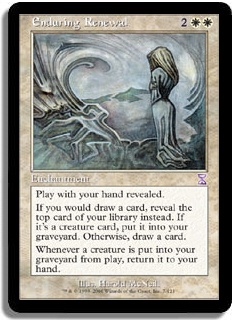I have looked through a fair number of the Top 8 decklists from States, and I haven’t found the combo decks. I haven’t seen any. Am I just missing something, or are they really not present? More importantly, is there a combo deck people just haven’t seen yet? Hint – I think so.
Let’s start by looking at what drives combo.
1) Fast mana
Fast mana powers out combo decks. Dark Ritual and Mana Vault powered the original Trix decks. Moxen and Mishra’s Workshop power out Stax and other Vintage combos. In Extended, TEPS is a perfect example of what you can do with an unusual manabase. Going further back, look at the Academy decks — is there any question that fast mana powered Academy and High Tide. Sure broken card drawing also powered the decks, but we will get there.
The current Standard has mana acceleration: suspended Lotuses, Coalition Relics, Mind Stones, Coldsteel Hearts, etc., etc. Adding Green gives us Birds of Paradise. We have mana acceleration.
2) Cheating the mana costs
Any cards that let you cheat on the mana costs have the potential to create a massive, combo-ish advantage. Look at classic decks like Tinker or Reanimator — both used cards that let you cheat out fatties or Mindslavers far earlier than they were intended to be cast. The same thing can be said about Tooth and Nail, Dragonstorm, and Enduring Ideal. Even if you want to argue that Tooth and Nail wasn’t really a combo (ignoring the Vampire/Triskelion and Kiki-Jiki/fliers builds), then look at Academy Rector (Carpe Nocturn), Oath of Druids, and Replenish decks. Cheating on the mana costs can power combos.
On the other hand, just because something can cheat on the mana costs does not make it a combo enabler. Elvish Piper can put a Colossus of Sardia into play for G — but that does not make it playable. Cards like Dragon’s Arch and so forth have always been around — as have reanimation cards like Living End. They only occasionally power anything. Even cards like Patriarch’s Bidding only work on occasion.
In Lorwyn, we have a couple of cards that can put creatures into play without paying their mana costs. Makeshift Mannequin is a rehash of Zombify (although instant speed makes it a good rehash, as the Top 8 at Krakow demonstrates.) The other options Lorwyn brings are the hideaway lands, Colfenor’s Urn and Deathrender. These all let you get creatures or spells into play for free — let’s see if they can combo off. Where they can or not depends on whether they have the third leg to the combo stool. (See, a combo needs three parts, like a stool needs three legs. A stool with three good legs is stable on any surface and works nicely. Stool also has another meaning — and a stool without legs, like a combo without legs, is crap.)
3) Tricky Symmetry
The third “leg” of any good combo is a tricky or abusive symmetry among the cards. If a Dragonstorm combo just produced four Shivan Dragons, it would be useless. Producing four Bogardan Hellkites (or Kokusho, the Evening Star), on the other hand, is a combo. Likewise, Trix was good, in part, because of the interaction of Donate and Illusions of Grandeur.
Tricky symmetry is another way of saying that a card has to be breakable. Let’s look at some possible combo enablers, and see what we can create.
The Three Rules:
I have three basic rules for combo decks — rules I have been writing about for years. Here’s the short version from an article written during Mirrodin block:
1) Find the pieces.
2) Don’t play bad cards.
3) Three pieces, or fragile pieces, make garbage.
In short, a combo has to be reliably able to find the combo pieces. This means tutors / card drawing / whatever.
The pieces have to be decent / playable even if you do not have the combo. Note that numbers one and two are a tradeoff — if you can reliably find the pieces very quickly, then playing the pieces over time is less important. For example, Trix was so potent and quick that it could ignore the fact that Donate, without Illusions, was terrible. On the other end of the spectrum, the Pickles deck plays a combo lock made up of creatures that are all good on their own.
The final rule is simply that 14 piece combo decks are cool for Magic the Puzzling, but not for actually winning the game. A ton of combos are technically possible, but most are simply too clunky and fragile to play. For example, I once build a deck around two Carnival of Souls, two Bottle Gnomes, two Anarchists, Living Death and Rocket Launcher — which was cute, but really, really stupid. It was the sort of thing that you play all evening and get to fire once.
Not a combo.
The Hideaway Lands
The first set of cards worth looking at is the Hideaway lands. These cards all allow you to play a card for a very nominal mana cost, but only in special circumstances. Here’s an example:

I think these lands fail the first rule — find your combo pieces. Let’s assume you can find an important piece to cast for one mana — you still have to find a way to get that card into the top four cards of your library, then play the land. It can be done, but then you still have to make sure that the trigger condition is met. That is a ton of work to play a single card. I can see playing the White hideaway in a weenie beats deck, since you will often get the trigger, and you can hide another attacker, and some of the others might work in some situations, but I cannot see trying to build a combo around these.
Let’s move on to another card:

At one point, I thought this card brought the creatures into play immediately, and I was working on some strange combo involving Cathodion, Eternal Witness and other creatures to pump their toughness enough to trigger the Urn when they were sacrificed. It was a kludge, but it was amusing. Then I reread the card and realized I had nothing. This looks like it could be nice in a Treefolk or Giants deck in Limited, but Wizards has neutered this enough to be useless in Constructed.
Moving on, we come to the one card that might be worth something:

Deathrender is a decent option. It puts the creature into play immediately. The mana cost is not impossible, and the equip cost is low. Putting this on something like a Mogg Fanatic allows you to control the sacrifice, meaning you can put a creature into play when you choose, instead of relying on an opponent to block or kill it.
If you just wanted to use this as a means of putting one fattie into play, you could play a self-sacrifice creature and equip that. The main self-sacrifice creatures are Mogg Fanatic, the Augurs, Bottle Gnomes, Triskelavus and so forth. That may work, but I don’t know how useful that is. What one creature would you want to put into play — and why is it worth all the trouble? After all, you can have Tarmogoyf for 1G, or you opponent’s Tarmogoyf for 2UU.
Putting one creature into play is not a combo, either. Let’s look at combos.
If you have a Gravedigger in hand, and another in play, you can equip one, sacrifice it, put the other into play equipped — which will bring the first back to your hand. Then you simply rinse and repeat. Each Gravedigger fetches another, and you can sacrifice and replay endlessly. Doing so is possible, but the question is “Why?”
One answer is to get a really big — lethally big – Nantuko Husk. Or, if you do not mind playing bad cards, you could also play Fallen Ideal. Either one provides both a sacrifice outlet and something worthwhile to do with the sacrifice. Both create a really large creature, although both then require you to actually hit the opponent with the creature in order to win the game. Chump blockers (or TurboFog) can screw this up.
Another option — and one I love for multiplayer games — is Bitter Ordeal. I swap Gravediggers a couple hundred times, and I cast Bitter Ordeal. Then I remove every card in every opponent’s library from the game, then simply pass the turn.
In Standard, you have three “gravediggers” — Gravedigger himself, Pit Keeper, and Warren Pilferers. All three are Black, as is Bitter Ordeal, Nantuko Husk, and even Fallen Ideal, so the mana works. The one drawback is finding the pieces — too bad Moonlight Bargain has left the format. You do have Diabolic Tutor, but that is awfully slow.
One option would be to splash Blue, for card drawing. Foresee and Careful Consideration would both be useful, as would some counters to protect the combo. Blue would also give you some bounce spells, to get rid of Pithing Needles set to shut off your sacrifice outlet.
The biggest problem with this combo is that it requires both the Deathrender and the sacrifice outlet. That is going to be tricky. You cannot play more Deathrenders (although you can play tutors), but you can play fall-back sacrifice outlets. Fallen Ideal is the worst, but it does work. Let’s look at some others.
If you splash Red, you can play Greater Gargadon. Gargs has some advantages: he is cheap, quick, and while he is removed from the game, relatively difficult to eliminate. Pithing Needle stops his activation, and Pull from Eternity and Riftsweeper do him in, but not much else. You can go infinite — just keep priority and activate the remove counter again and again in response. Gargs meets one critical test for a combo piece — he is good even without the combo.
Standard, right now, does not have a lot of other reusable sacrifice outlets — but it does have one. Thermopod is often forgotten, but it is legal. You can sacrifice a creature to Thermopod and generate one mana.
Two gravediggers, Deathrender and a Thermopod can generate “infinite” Red mana. An unbounded supply of Red mana should be enough to kill anyone. Blaze is legal — as are a ton of better alternatives. Better yet, if you are worried about having a Disintegrate countered, sacrifice a gravedigger one more time and put Shivan Hellkite into play. Hellkite is a machine gun.
If one of the gravediggers is Warren Pilferers, a goblin, you could also run Goblin Shenanigans. That would also act as a machine gun.
I was looking for alternatives to the Deathrender, but I really cannot find one. Nothing else lets me put a creature into play for free. However, what I really wanted was a way of putting something back into my hand, in order to put it back into play with Deathrender. Two Gravediggers seems clunky. It would be far better to be able to chain other creatures.
Then I looked at this card:

Enduring Renewal puts the creature back into your hand. It is a triggered ability. Deathrender is a triggered ability. Both trigger on the same event, so I can stack them.
Deathrender’s “put something into play” ability goes on the stack first. Note that it does not target.
Enduring Renewal’s “back into hand” goes on the stack next. It resolves first. The creature is back in my hand when I choose what creature is going to go back into play.
In short: Bottle Gnomes, Enduring Renewal and Deathrender in play. Equip Bottle Gnomes. Sacrifice it 5.4 pazillion times. Go to 16.2 pazillion life.
Nifty.
Enduring Renewal, Deathrender, and Mogg Fanatic in play. You’re dead.
Even if you were at 16.2 pazillion life.
With both Deathrender and Enduring Renewal, I get two combo conditions, and some redundancy.
Let’s look at some combos:
Enduring Renewal, DeathRender, Mogg Fanatic = Kill
Enduring Renewal, Thermopod, Mogg Fanatic, and a storm card = the nuts. The storm card can be Empty the Warrens, Bitter Ordeal or just Grapeshot.
Enduring Renewal, Thermopod, and Ornithopter = a massive storm count and infinite Red mana. Just add Mogg Fanatic, Grapeshot or Siege-Gang Commander.
Enduring Renewal, Thermopod, and Mogg War-Marshal = infinite Red mana.
Enduring Renewal, Thermopod, Mogg Fanatic, and Boggart Shenanigans = infinite storm count and damage.
Thermopod, Greater Gargadon, and Mogg Fanatic = a Gargadon in play and a storm count of ten. Note that you cannot go infinite with Gargadon as the enabler: you cannot play a creature in response to the Gargadon’s remove a counter ability. This means that you can only rinse and repeat until the Gargs enters play. Still, having a Gargadon in play the same turn you suspend him is not a bad thing.
Unfortunately, I have not had any time to tune the deck. (I’m already almost a day behind deadline as is.) However, here are the building blocks so far:
Engines:
Sacrifice outlets:
Nantuko Husk
Greater Gargadon
Thermopod
Kills and utility
Gravedigger
Warren Pilferers
Grapeshot
Bitter Ordeal
Mogg Fanatic
Siege Gang Commander
Shriekmaw
Mogg War Marshal? Ornithopter?
Manabase
Coalition Relic
Lands
Note the Shriekmaw — Shriekmaw, and all evoke cards, are kind of nifty with Enduring Renewal. Evoke them, they come back for free.
The one big drawback with Enduring Renewal, however, is that once it is out, you cannot draw into the creatures you need. Getting around that requires some tricks. Abundance would do the job, but a third color is a problem. A better option might be some non-creature Raise Dead effects, or Makeshift Mannequin. Note that Mannequin and equipment, however, are a non-starter.
It’s just a shame that decks like this don’t work well online. Bitter Ordeal kills are simple in paper multiplayer, but require too many clicks online. You have to tune a deck like this in paper. I haven’t done that, yet. I haven’t even searched White and Black for other cards that might be worth adding. This is very much a work in progress.
If I do make progress, you may hear about it in future weeks.
PRJ
“one million words” on MTGO

